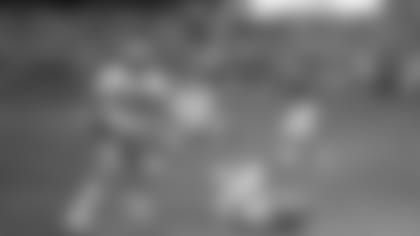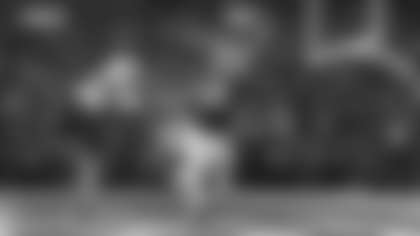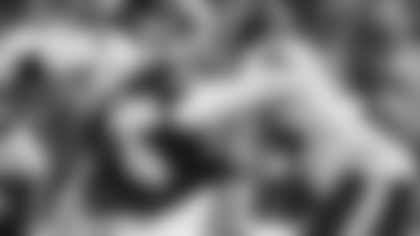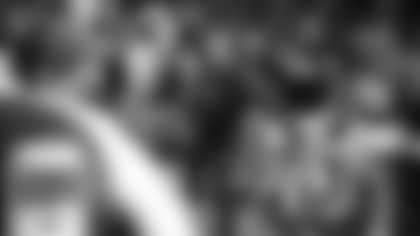Just Google it.
Hail Mary.
Clicking on the first drop-down brings up the universally-known prayer, Hail Mary full of grace the Lord is with thee…
Now the second drop-down is Hail Mary pass.
Click on it.
Up comes the description of one of the most famous plays in not just the now 60-season history of the Dallas Cowboys, but in the entire 100-year history of the National Football League, which coincidently is being celebrated this year.
You know, that last-second heave. Cowboys quarterback Roger Staubach, with 32 seconds left in the NFC playoff game against the heavily favored Minnesota Vikings on Dec. 28, 1975, at old Metropolitan Stadium in Bloomington, Minn., with the Cowboys trailing, 14-10, throwing up a desperation 50-yard pass to wide receiver Drew Pearson for the winning touchdown.
That's 45 seasons ago, but to this day, Nov. 10, 2019, with the Cowboys meeting the Vikings at AT&T Stadium, be careful mentioning this moment to someone sitting next to you in a Minnesota jersey. Some stings just don't ever go away.
Staubach tells the story of running into a Vikings fan at The Star, in Frisco, Texas, the Cowboys World Headquarters they moved into in 2016, and recalls the man saying, "Yeah, don't bring up the Hail Mary. I'm still mad about it."
Or Pearson likes to tell the story about when he was doing business up in Minnesota, flying into Minneapolis, hailing a cab, and the cab driver takes one look at him and says, "Are you Drew Pearson?" and Pearson says, "Yes sir," and the cabby shoots back, "I'm not taking you anywhere. Take the next cab."
"Three cabs later I finally got a ride," Pearson said.
The popularity and notoriety of this play is the reason the Cowboys, when constructing The Star and trying to depict their history throughout the sprawling building, decided the Hail Mary would become the centerpiece attraction.
"When we were thinking of all the iconic moments in our history, you know, we had the greatest plays that were acknowledged. So when we decided to build The Star, it was about bringing to life the tradition and history of the Dallas Cowboys," said Charlotte Jones Anderson, the Cowboys executive vice president/chief brand officer who had an intimate hand in the design of the building. "And in that, our thoughts were around how best do we do that, how best do you retell the story, the story that has been told. It's been told in a book, so how do you give it a new life, a new presence.
"Trying to actually break that down to get people to see it in a different way, the people we were creatively working with in this space, we were looking at the play, but because of the granulation of the play in which it was filmed was a little degraded, how could we actually capture what was going through Roger's head at the time since he really drew it up like a sandlot play – 'I'll find you, you go deep.' And they thought, let's just break it down as a picture, as an old-timey picture, like a photo book, which you see frame by frame by frame by frame. Put that all together and do it in a very artistic way."
Thus in The Star's three-floor marbled staircase in the middle of the building, the Cowboys, with the help of Advent, the company that designed the interior decorations of the team's history, came up with this idea of hanging down the middle a frame-by-frame series of photos of the Hail Mary play. Thirty-six frames in all, the pictures starting with Staubach taking the snap and ending with Pearson in the end zone all in step-by-step succession.
Certainly the highlight for those taking tours of The Star, reliving the history of the Cowboys in so many different ways.
There were some hurdles accomplishing this project. NFL Films did not have a complete video of the play the Cowboys were looking for, so they went to CBS, the network televising that playoff game. Bingo, the video still was in workable shape.
Then the charge was, "How do you take the actual video and extrapolate it into something that is visually pleasing, that's artistic and new, and present it in a completely different way than anyone would ever expect," Anderson said.
Well, they certainly accomplished that goal. Folks taking tours continue to gawk at the depiction of this iconic play. And even employees who walk up and down the steps daily still catch themselves looking at those 36 frames, top to bottom or for that matter, bottom to top.
"And it's been a hit," Anderson said with complete certainty.
As for the players, they weren't aware that any of this was in the works.
"No idea," said Staubach, adding, "That's a really neat deal, having our kids and grandkids over here. 'Hey, you got to go see the Hail Mary.'"
Pearson said he found out about the display the first time he walked into The Star.
"I saw it, and I was stunned," he said. "Almost started to cry, because to be depicted like that, it's the greatest play in Cowboys history, there is no question about it, but how do you display that? The Cowboys came up with a very creative way to display it and, you know, I'm proud of it being there.
"Man, if I had a house big enough (laughing), I'd do the same thing."
Yep, it's that impressive.
The 1975 season was supposed to be a rebuilding year for the Cowboys. So many players had retired, including Bob Lilly, Walt Garrison and Cornell Green. Calvin Hill bolted for the World Football League. This was the year of the "Dirty Dozen," 12 draft choices making the team, one that went 8-6 the previous season, ending a streak of eight consecutive playoff appearances that included two NFL Championship Games they lost to Green Bay and two Super Bowls, losing in Super Bowl V to Baltimore but winning it all the next year in Super Bowl VI against Miami.
The Cowboys got off to an average 5-3 start in 1975, but would win five of the final six games to finish 10-4 and earn a wild-card berth into the playoffs. Because of that, they would have to go up to Minnesota to face the heavily favored Vikings squad, winners of the NFC Central with a conference-best 12-2 record after beginning the season with a 10-game winning streak.
The Vikings, behind Hall of Fame quarterback Fran Tarkenton, were leading 14-10 after scoring the go-ahead touchdown with 5:41 to play. Then they forced a Cowboys punt, but on a third-and-2 during the Vikings next possession, Cowboys safety Charlie Waters dropped Tarkenton for a 3-yard loss, forcing a Vikings punt.
So here we go, Dallas with the ball at its own 15-yard line, just 1:51 to play. After gaining one first down, the Cowboys, with only 44 seconds left, no timeouts, were facing a fourth-and-16 at their own 25.
"Drew Pearson made this unbelievable catch on the sideline that people don't realize how important that was," Staubach remembered. "He made it for 25 yards, got hit and knocked out of bounds, and the usher came up and kicked him – while he's on the ground. And there is a video of that, too. So they really didn't like us up there." (More on this later).
Now it's first-and-10 at the 50. Just 37 seconds left. Staubach's pass to Pearson fell incomplete. Now only 32 seconds remaining.
At that point, in dire straits, late Cowboys head coach Tom Landry would be quoted as saying after the game, "Our only hope was to just throw it and hope for a miracle," another ecclesiastic term for what was going to transpire.
Here were Staubach's words in the huddle:
"So basically I told everybody to go block, this will be pretty simple, and Drew go deep, run an in route and I'll look the free safety off. I was in the shot gun. In fact, in 1975, the creativity of the Cowboys, we put the shotgun in. Nobody else was in the shotgun, and they thought we were crazy. We used it on third down and in the two-minute period. Coach Landry put that in in 1975.
"So I was in the shotgun, and when I threw it, I looked Paul Krause off, he was the weak safety and Nate Wright was the cornerback. I pumped over here (looking to his left), but by the time I turned back, I intentionally underthrew Drew (a fit of sarcasm), uh, so he could catch it on his hip. No, I really underthrew him because I pumped too much over this way (to his left)."
Now Drew's side of the story:
"(Wright) bit on the turn in, but when I came out we were neck and neck. And the only other guy he told to go out on the play was Golden Richards to run a post pattern down the other side, the left side. Billy Joe [DuPree] stayed in for maximum protection. Everybody else is blocking. And what he wanted to do was hold safety Paul Krause, who still today is the NFL's all-time interception leader. And most of his interceptions are overthrows because he plays so deep. So we just wanted to hold him there.
"Now I'm man to man on Nate Wright, so he pumps Golden and he comes back to me. I've run the turn and take off, and I'm down field. And I'm thinking me and Nate are even, and I'm looking back. I know I had that one gear that I could shift into to make the separation and go get the ball, catch it in the back of the end zone, do the toe dance and touchdown Dallas, right?
"But the ball was underthrown, so I see that and then I use the swim move, right, to get the inside position. Use my outside arm and bring it in, and while doing that there was contact on Nate. And with that contact, he fell down. No, there's no flag. And the ball hit my hands and slithered through my hands and stuck between my elbow and hip. And I look down and said, 'Oh Lord, I even caught the Hail Mary.'"
Well, it wasn't quite the Hail Mary … yet.
From the 5-yard line, Pearson backs into the end zone with 24 seconds left for what turns out to be the game-winning touchdown to send the Cowboys to Los Angeles to meet the Rams in the NFC title game the following week.
As for Staubach, who was hit after the throw, "Well, I'm on the ground, I didn't even see it, and because I didn't hear the fans yelling and screaming, I said, 'Ooh, something good must have happened.' Because the game would have been over basically. So the fans obviously saw Drew go into the end zone and I didn't see it."
Then Drew did something he's always regretted. Mostly because the night before the game he said he had this dream of catching the winning touchdown and then firing the ball into the stands, a move that came with a $150 fine.
"But I said heck with it. It's on national TV, playoffs, I'm throwing that ball," he said. "But it turned out there were no stands there. It was a scoreboard and the parking lot. So the ball ended up in the parking lot. Then I got mobbed afterward."
The ball never to be found again. "No one has ever said they have the ball," Pearson claimed, knowing full-well how much that item would have been worth.
But then, all hell broke loose. The Vikings fans thought interference should have been called on Pearson for pushing off. The field became littered with oranges, since the confident but now frustrated Vikings fans thought for sure Minnesota would be going to the Super Bowl at the Orange Bowl in Miami and came prepared to celebrate. And then came the empty whiskey bottle, hitting official Armen Terzian in the head, causing a huge gash to bleed profusely.
"So he's kneeling on the field, bleeding," Staubach remembered. "We're on the sideline – the teams were both on the same sideline. And it got silent and it got eerie, and Coach Landry, he didn't cuss, but he said, 'We've got to get the (heck) out of here.' It was eerie."
Well, the Cowboys survived the angry fans and the final 24 seconds, and the win left the Rams celebrating, too, since they now did not have to come to Minnesota to play the NFC title game and would be playing the wild-card, underdog Cowboys for the conference championship at home – they figured a huge break that instead would ultimately backfire.
Now for the rest of the story, how the Hail Mary in terms of football was coined, Catholicism intersecting with the pigskin.
"It was in the locker room. It was an Associated Press writer I believe who picked it up," Staubach said. "I was a Catholic kid from Cincinnati, and they asked me what were you thinking about when you threw the ball, and I said, "When I closed my eyes I said a Hail Mary. I could have said Our Father, Glory Be, The Apostles Creed.
"So he picked it up and gradually, instead of the bomb or the alley-oop, those were kind of the big plays winning games back then, he coined the phrase and, of course, I said it, the NFL recognizes I said it, and slowly but surely it took off. Now it's used for everything."
Thus the Hail Mary, once again these Cowboys influencing the NFL in yet another way.
Now it's been 45 seasons since the 50-yard erstwhile bomb gave birth to the term Hail Mary, this off-the-cuff remark from Staubach sending it forever more into football vernacular when heaving a desperation pass against all odds while hoping – praying – for the very best.
"I have always been proud of that because I figure The Blessed Virgin will not allow me to go to hell … bring her into it," Staubach said with a smile. "Now it's really used for everything. If you've got a problem or something, you need a Hail Mary."
Just like the Cowboys, that play propelling them into that NFC title game, pummeling the unsuspecting Rams, 37-7, to earn the right to play in Super Bowl X where they lost that close call to the Pittsburgh Steelers, 21-17.
Still, this play has not been placed in an obscure time capsule. To this day, Hail Mary lives and breathes throughout the NFL. If you think not, ask a Vikings fan. Those folks know exactly what you're talking about. Staubach and Pearson are living proof of the sustained bitterness.
"I spoke at a Chamber of Commerce deal in Minnesota, the Super Bowl was there," Staubach said of Super Bowl LII on Feb. 4, 2018. "So I was speaking there at the luncheon and I got booed. It was kind of a fun boo, but it was a boo."
But nothing beats Pearson's story, not even the one of him getting kicked out of the cab in Minneapolis. Remember his fourth-down, 25-yard catch sliding out of bounds for the all-important first down at the 50-yard line that stopped the clock?
"I did a signing up there a couple of years ago (in Minneapolis) and sitting next to me at this autograph table is this usher," Pearson said. "He's got the uniform on, the security on the back, his little hat. He's got football playing cards with his picture on it, with the history of his résumé on the back of the card."
Yep, this is the guy who was serving as a sideline usher on that frigid Dec. 28, 1975, day who was so beside himself as Pearson slid into his path after the catch for that critical first down that the guy actually kicked the receiver while he was on the ground, as if to say, yeah, take that cool guy. Check it out. It's on the tape of the TV broadcast.
So of all things, this security guard is at the very same table signing autographs, too, at this event, as if he had become some sort of cult hero for his act of bitterness.
"This guy has been making a living out of that, the guy who kicked Drew Pearson two plays before the Hail Mary," Pearson said. "And he gave me his number, and said keep in touch. I said, 'Yeah, sure.'"
This play still living a life of its own.
Yes, the Hail Mary lives on, and now in 36 frames of living color at The Star for perpetuity. The play. The memory. The meaning.
"The Hail Mary became bigger than what actually transpired there on that day," Anderson said. "On that day it was important, but wow did it become significant in the world of sports, in the world of football, but certainly for us.
"It's almost like when I'm talking about it I shouldn't be saying that. I'm very spiritual, very religious, so it's like oh, no, please forgive me. However, this is it."
Sure is. Just Google it.
Hail Mary.







